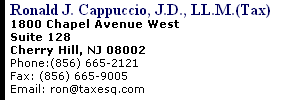For many business owners and executives,
filing Chapter 11 bankruptcy seems like admitting defeat. But
it shouldn’t be that way.
The bankruptcy code exists to
provide second chances. Chapter 11, which covers
|
New Bankruptcy Law
Passed A
wide-ranging law that brought major changes to the
country's bankruptcy laws was signed by President Bush
on April 20, 2005 and went into effect on October 17,
2005. Under the Bankruptcy Abuse Prevention and
Consumer Protection Act, it is now more difficult
for individuals to file for Chapter 7 bankruptcy, which
wipes out most unsecured debts — including credit card
debt. Lawmakers say the changes, which prohibit some
individuals from filing for bankruptcy altogether, are
necessary because the number of filings remain at
historic highs.
In addition to the
major alterations in consumer bankruptcy, the
law brought numerous changes for business
bankruptcy cases, including different rules for
reorganizing under Chapter 11. And it created a new
chapter of the Code, Chapter 15, which addresses
cross-border insolvency. |
|
Chapter 11
immediately freezes all financial claims against the
company and stops lawsuits and collection
activities.
|
business reorganizations, allows
struggling companies to right themselves so that they may once
again be profitable engines of the nation’s economy.
No provision in the bankruptcy code is more important
to achieving this goal than the automatic stay
provision of Section 362.
The automatic stay
provides a time-out — a window of opportunity to fix problems.
In some cases, time is all that’s needed.
Whenever a
company — or an individual — files for bankruptcy, the
automatic stay kicks in. All debt collection actions against
the company must temporarily cease. Like a temporary
injunction, the automatic stay prohibits any action by a
creditor against the debtor or its property.
Some
actions are prohibited by creditors under an automatic stay.
The automatic stay affects even the Internal Revenue Service
(IRS). While the stay is in place, the IRS is generally
prohibited from issuing tax liens or seizing
property.
There is one major difference between the
automatic stay in bankruptcy and a normal temporary
injunction: No hearing is needed for the automatic stay to
take effect. It occurs as soon as a petition to file for
bankruptcy is stamped at the court.
A company can
then move forward without fear. The bankruptcy court has the
power to punish creditors that knowingly violate a stay by
filing a contempt charge against them. Harassing letters and
phone calls should stop. If they don’t, notifying the court of
a creditor’s transgression generally ends the
problem.
While the automatic stay is in place, the
debtor company is prohibited from paying most of its
pre-petition debts. This provides a chance for the company to
rebuild itself as a going concern.
You might think that
filing for bankruptcy to get an automatic stay sounds
all-well-and-good, but filing will surely dry up the pool of
available credit for things such as operating expenses. Won't
bankruptcy tie the company’s hands and kill any hope of future
success? This is rarely the case. Generally, a struggling
company has an easier time obtaining credit once
bankruptcy has been filed and the automatic stay is in
place.
Credit availability tends to increase because of
the prohibition against paying pre-existing debts. All debts
incurred after bankruptcy has been filed
(post-petition debts) must be paid first, before any
pre-petition debts. As long as the company shows that it can
operate profitably if it doesn’t have to immediately pay its
pre-petition debts, credit is likely to be
available.
Consult with a professional about the best
way to proceed. And keep in mind that corporations that
successfully come out of bankruptcy almost always do so
because of fruitful negotiations with creditors. The automatic
stay is not a cure all. For some businesses, no amount of time
can fix things. But for a company that is fundamentally
strong, with credit in hand, the automatic stay provides an
important opportunity to talk to creditors and get back on
track.

|
































